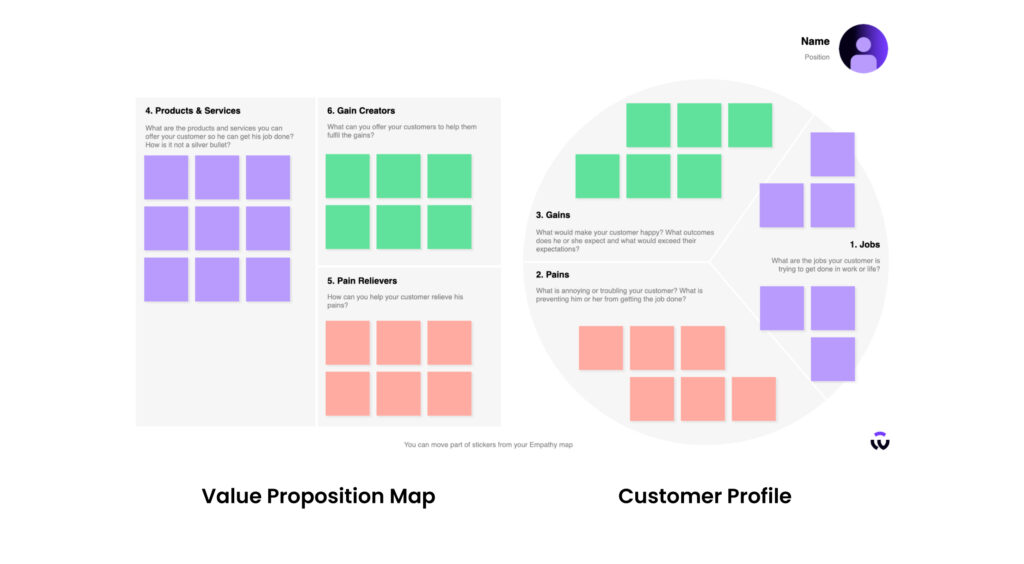Value Proposition Canvas Explained (With an Example Template)
In today’s competitive business landscape, understanding your target audience and delivering value to your customers is crucial. Customers are driven to make purchases when they find products or services that fulfil their needs — and they’re willing to pay for the value they receive.
The value proposition canvas is a valuable tool that helps you align your products with your customer’s preferences and stay attuned to their evolving needs and desires.
In this article, we will delve into the concept of the value proposition canvas, explore its benefits, discuss practical examples, and provide insights on how to leverage it for maximum effectiveness.
What is a value proposition canvas?
A value proposition canvas is a strategic tool that enables businesses to analyze, design, and refine their value proposition. It serves as a visual framework for defining what the customer values and ensures that your product meets the desires and demands of your target market.
The value proposition canvas, an extension of the business model canvas, was developed by Alexander Osterwalder. Recognizing the necessity to connect value propositions with customer needs, Osterwalder designed this canvas model as a solution.
Suggested reading: If you want to find out more, check out our blog Value Proposition Canvas Template: The Windmill Guide
Value proposition example
Uber is a great example of a company that has crafted a unique value proposition. Through clever messaging, Uber effectively addresses the drawbacks of traditional taxi services while highlighting its superior offerings.

The concise yet impactful copy found on Uber’s homepage above highlights the simplicity and convenience that lies at the core of its service.
- With just a single tap, a car arrives at your location
- The driver already knows your destination
- Payment is cashless, eliminating the hassle of cash payments
This is the opposite of the traditional taxi experience, where riders have to call taxi companies, explain where they want to go to stressed-out drivers, and fumble around looking for change to pay.
Suggested reading: If you want to discover more powerful value proposition examples, check out 7 of the Best Value Proposition Examples We’ve Ever Seen
Why should I use a value proposition canvas?
There are loads of great reasons to use a value proposition canvas in your company. Let’s look at some of the key benefits:
Gain valuable customer insights
Understanding your target market is essential for any business, especially startups. Utilizing the value proposition canvas enables you to gain valuable insights into your customers, their preferences, and the specific aspects they seek in products like yours.
Validate your product’s value proposition
Your assumptions about your products and target audience may be incorrect. The value proposition canvas allows you to adopt your customer’s perspective, enabling you to view your product from their viewpoint. This means you can identify and eliminate ideas that are unlikely to succeed before investing valuable resources in testing and development.
Improve your marketing efforts
Using a value proposition canvas, you can identify what features hold the highest value for your customers. This will enable you to focus your marketing efforts, tailor your messaging, and create powerful campaigns that resonate with your audience.
When should I use a value proposition canvas template?
Here are some key situations where using a value proposition template can prove particularly beneficial:
- When you are developing new products
- When you are testing product-market fit
- When you are refining your marketing strategy
- When you are looking for ways to boost your product sales
- When you are updating existing products with new features
- When you want to gain a deeper understanding of your target market
How does a value proposition canvas template work?
Our value proposition canvas template is fairly easy to use, but you need to pay careful attention to each segment and fill them in correctly.

The template consists of two main sections: the Customer Profile, depicted in the circular section, and the Value Proposition section, represented by the square section. It is divided into six segments, each capturing specific information related to different aspects of a value proposition.
Customer Profile section
The Customer Profile section is located on the right side of the template and we recommend filling it in first. This is where you can provide detailed information about your customers’ characteristics.
The Customer Profile segment comprises three sections: Customer Pains, Gains, and Jobs — we will look at these in more detail below.
Segment 1: Jobs
In the value proposition canvas, customer jobs encompass various tasks, problems, or desires that customers aim to accomplish, solve, or fulfil. There are three main types of customer jobs to consider:
- Emotional Jobs: relate to the customer’s feelings and preferences
- Functional Jobs: simple and practical tasks
- Social Jobs: motivated by reputation and sense of duty
By understanding and addressing these customer jobs, you can better tailor your offerings to meet customer needs and enhance your value proposition.
Segment 2: Pains
Customer pains refer to any factors that hinder customers from completing the identified jobs. They can be seen as obstacles that customers must overcome or negative outcomes they wish to avoid.
Categorizing these pains as either minor or severe can aid in prioritization during subsequent steps. This stage is crucial for understanding problems from the customer’s viewpoint and gaining valuable insights into their pain points.
Segment 3: Gains
Gains can be defined as the positive experiences and desires that customers aspire to achieve. They represent the aspects that motivate customers to use a particular product or service.
By understanding the gains that customers desire, you can effectively attract and engage your target audience.
Value Proposition section
Now, let’s move to the left-hand side to fill in the square where the value proposition map is introduced. Similar to the circle, this section is divided into three parts and focuses on your company’s products and services.
Segment 1: Products and Services
This segment focuses on the specific products and services offered by your company, which generate value for the customer. These can include both new and existing products.
Segment 2: Pain relievers:
Within this segment, you list the features of your products and services that alleviate your customer’s pains. You don’t need to describe how the pain is relieved in detail — a simple statement will do.
Segment 3:Gain creators:
In this segment, you identify the benefits that customers gain from using your products or services. You explore how your offerings enhance their lives and help them achieve their goals.
Tips to use a value proposition canvas effectively
Here are some valuable tips to maximize the effectiveness of the value proposition canvas:
- View each component: Understand that the Customer Profile and Value Proposition sections are interconnected. The Customer Profile helps identify customer needs, while the Value Proposition integrates those findings to enhance product quality.
- Start with the customer: Begin by thoroughly understanding your target customer and what they value the most. Conduct rigorous research to gain a deep understanding of their needs, desires, and challenges.
- Fill in each segment thoughtfully: Pay attention to each segment of the template and fill them in with relevant information. Make sure that each segment has its own unique jobs, pains, and gains — avoid the mistake of lumping everything in one Customer Profile.
- Think like a customer: When drafting a customer profile, put yourself in the customers’ shoes and consider their daily activities and goals. By thinking like a customer, you can identify where your product may be lacking and understand what drives their purchasing decisions.
- Continuously learn and adapt: Leverage the insights gained from the value proposition canvas to continuously adapt and refine your value propositions.
Final thoughts
The value proposition canvas is a powerful tool that helps companies align their products with customer preferences and create value that resonates with their target audience.
You can use the template in various situations, including product development, testing product-market fit, updating existing products, and gaining a deeper understanding of your target market.
For professional guidance from a skilled design team, reach out to us today and discover how Windmill can assist your business in refining its value proposition, business model, and other essential strategic pillars.


